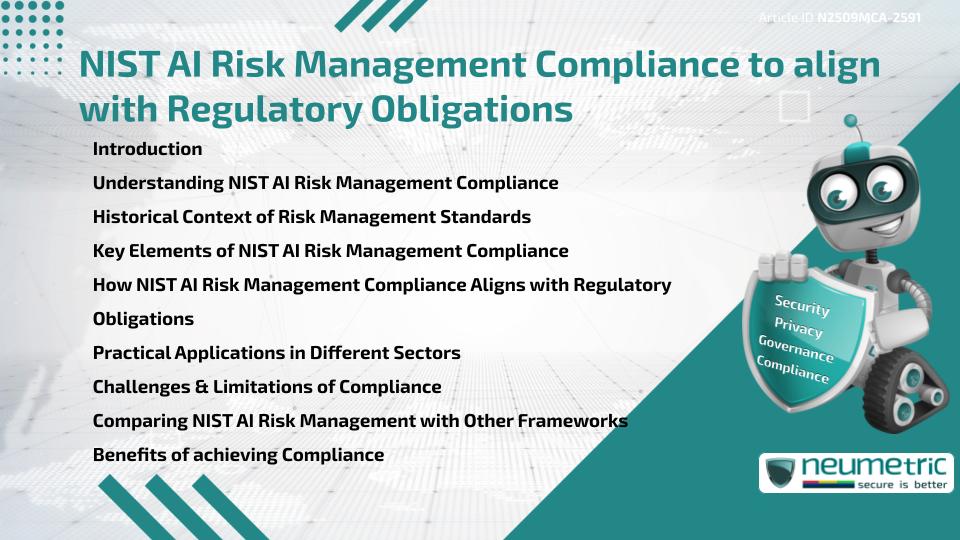Table of Contents
ToggleIntroduction
NIST AI Risk Management Compliance is a structured Framework designed to help Organisations manage the Risks associated with Artificial Intelligence systems while meeting regulatory obligations. It provides practical guidance for identifying, evaluating & mitigating potential harms. By adopting this compliance model, Organisations not only enhance trustworthiness in their AI applications but also align with laws & Industry Standards. This makes it a critical tool for businesses that need to balance innovation with accountability.
Understanding NIST AI Risk Management Compliance
The National Institute of Standards & Technology [NIST] developed the AI Risk Management Framework to guide Organisations in managing Risks linked to Artificial Intelligence. NIST AI Risk Management Compliance emphasizes fairness, transparency & accountability. It helps entities establish controls to address ethical concerns, system reliability & security challenges. In essence, it is about creating responsible AI that operates within clear boundaries of trust.
Historical Context of Risk Management Standards
Risk Management standards have evolved over decades, with early models focused primarily on Financial & operational Risks. With the rise of digital technologies, frameworks such as ISO 31000 & SOC 2 expanded the scope to include Information Security & operational integrity. NIST AI Risk Management Compliance builds upon this legacy, applying lessons from Cybersecurity & Data Protection frameworks to Artificial Intelligence.
Key Elements of NIST AI Risk Management Compliance
NIST AI Risk Management Compliance consists of structured practices, including:
- Mapping AI System purposes & intended uses.
- Measuring Risks by identifying possible harms to individuals or communities.
- Managing Risks through Policies, technical safeguards & monitoring mechanisms.
- Governing the entire process with accountability, oversight & Continuous Improvement.
This step-by-step approach ensures that Risks are not only identified but also actively reduced.
How NIST AI Risk Management Compliance Aligns with Regulatory Obligations
Regulators across the world are creating rules for AI applications. For instance, the European Union AI Act & the U.S. Blueprint for an AI Bill of Rights emphasize transparency & fairness. NIST AI Risk Management Compliance supports Organisations in demonstrating due diligence to regulators. By aligning Risk Management practices with legal requirements, Organisations reduce penalties & safeguard their reputations.
Practical Applications in Different Sectors
NIST AI Risk Management Compliance is applicable across industries:
- Healthcare: Ensuring AI diagnostic tools do not exhibit bias.
- Finance: Reducing Risks of discriminatory lending practices.
- Manufacturing: Enhancing safety in AI-driven automation.
- Government: Supporting ethical use of AI in decision-making systems.
In all cases, compliance ensures AI is used responsibly without undermining trust.
Challenges & Limitations of Compliance
Despite its strengths, NIST AI Risk Management Compliance is not without challenges. Implementing compliance requires significant resources, expertise & cross-functional collaboration. Smaller Organisations may struggle with costs & technical barriers. Additionally, since AI Risks evolve quickly, frameworks must adapt regularly, which can strain organizational resources.
Comparing NIST AI Risk Management with Other Frameworks
NIST AI Risk Management Compliance shares similarities with frameworks like ISO/IEC 23894 for AI Risk & the EU AI Act. However, NIST’s approach is more flexible & voluntary, focusing on Risk Management rather than prescriptive regulation. This adaptability makes it appealing for Organisations seeking guidance without rigid mandates.
Benefits of achieving Compliance
The advantages of NIST AI Risk Management Compliance include:
- Strengthening trust with users, regulators & Stakeholders.
- Reducing operational & legal Risks.
- Enhancing Transparency & Accountability.
- Improving competitiveness by showing commitment to responsible AI.
By embedding compliance into AI Operations, Organisations position themselves as leaders in ethical innovation.
Takeaways
NIST AI Risk Management Compliance provides a structured way to manage Risks in AI Systems while aligning with global regulatory expectations. Though implementation may be resource-intensive, the benefits of trust, transparency & reduced legal exposure far outweigh the challenges.
FAQ
What is NIST AI Risk Management Compliance?
It is a Framework by NIST that helps Organisations identify, assess & mitigate Risks associated with Artificial Intelligence while aligning with regulatory obligations.
Why is NIST AI Risk Management Compliance important?
It ensures AI Systems are fair, reliable & transparent, which helps Organisations meet legal requirements & build trust.
How does it differ from the EU AI Act?
The EU AI Act is a binding law, while NIST AI Risk Management Compliance is a voluntary Framework that offers flexible guidance.
Can Small Businesses adopt this Framework?
Yes, although smaller Organisations may face challenges with resources, they can scale the Framework to their capacity.
Which industries benefit most from compliance?
Healthcare, Finance, Manufacturing & Government sectors particularly benefit due to the high Risks of bias, safety & accountability.
Does NIST AI Risk Management Compliance replace other standards?
No, it complements existing standards such as ISO & SOC frameworks by focusing specifically on AI Risks.
Is compliance mandatory?
No, it is voluntary but highly recommended, especially for Organisations seeking alignment with evolving regulations.
References
Need help for Security, Privacy, Governance & VAPT?
Neumetric provides organisations the necessary help to achieve their Cybersecurity, Compliance, Governance, Privacy, Certifications & Pentesting needs.
Organisations & Businesses, specifically those which provide SaaS & AI Solutions in the Fintech, BFSI & other regulated sectors, usually need a Cybersecurity Partner for meeting & maintaining the ongoing Security & Privacy needs & requirements of their Enterprise Clients & Privacy conscious Customers.
SOC 2, ISO 27001, ISO 42001, NIST, HIPAA, HECVAT, EU GDPR are some of the Frameworks that are served by Fusion – a SaaS, multimodular, multitenant, centralised, automated, Cybersecurity & Compliance Management system.
Neumetric also provides Expert Services for technical security which covers VAPT for Web Applications, APIs, iOS & Android Mobile Apps, Security Testing for AWS & other Cloud Environments & Cloud Infrastructure & other similar scopes.
Reach out to us by Email or filling out the Contact Form…


